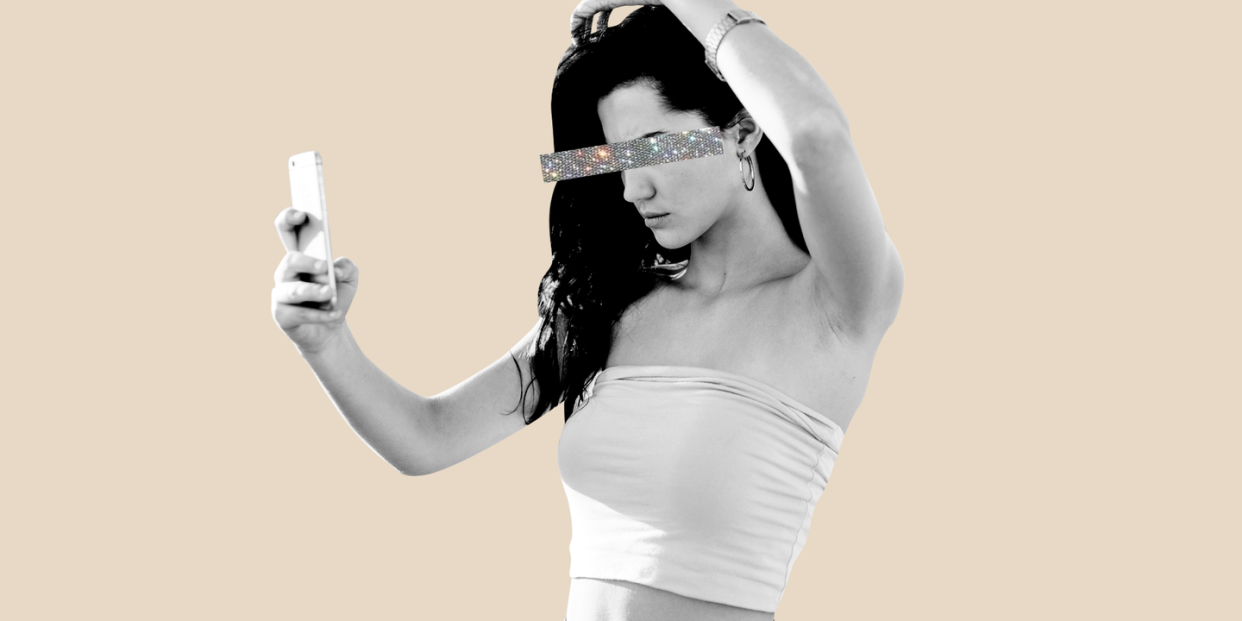Dear TikTok, Please Take Down the Inverted Filter

It wasn’t the first time I didn’t understand something on TikTok. But it was the first time I had literally no idea what was happening in the videos. Maybe it was because the reaction I saw in each clip (gasps, laughter, screams, actual tears) didn’t line up with what I was actually seeing (a regular person just staring at themselves). There were also bizarre captions and comments—people “joking” about having body dysmorphia and seeming straight-up depressed. It was like watching the first scene of Bird Box.
What I'm referring to is the hell that is TikTok’s “inverted” filter. It basically flips your face and body to the opposite of your mirrored reflection—you know, the one we more commonly see in, um, mirrors and selfies. The trend: look at yourself regularly (not inverted), then look at yourself inverted, highlighting how asymmetrical (read: “ugly”) your face or body is. Like most social media things, it has little value other than to make you feel weird (or worse).
TikTok user @rachtastic126 wiped tears from her eyes, captioning her video: “I hate this trend. I feel so ugly.” @Madozilla literally screamed when she saw her face, then leaned closer to the camera, flipping back and forth and covering her mouth in silence. In @samshapiroo’s video, she cried and wrote: “TIKTOK PLEASE DELETE THIS FILTER I'M BEGGING YOU.” @Maelynesque made one in response saying, “It’s not that bad, I’ll show you.” She then put the filter on her face and covered her mouth. “Oh my god, I stand corrected, please delete this.”
Of course, TikTok didn’t invent “Snapchat Dysmorphia.” Other apps have filters, like the lip plumping effect, that show us fake, “prettier” versions of ourselves. And the whole "seeing yourself in a mirror for the first time" phenomenon dates back to the advent of selfies.
But the current inverted filter situation is so messed up because of the way people are using it. If you scroll long enough on the filter's page, you'll find two totally distinct groups of people—those who are “hot” and those who are not. It’s a biological belief that having a symmetrical face equates to beauty. While we would like to think we are evolved enough to know that this is untrue—PSA: you can obviously be beautiful without perfect symmetry—the reactions to the filter reveal that this belief is still a deep-seated one.
This filter, separating us into those who are symmetrical and those who aren’t, sends the message that if you’re not hot, you can’t sit with us. Or worse—if you’re seen as “ugly,” you might go viral for even trying.
While claiming that a TikTok filter gave you body dysmorphic disorder (BDD) isn’t the same as actually being diagnosed, it's obvious that the filter is still causing harm. And let's be clear: BDD is on the rise in adolescents thanks to social media filters, according to research published by the Journal of Family Medicine and Primary Care in February of 2020. (Nineteen-year-old @rosegoldzebra says she needs a nose job after using the filter.)
I’ve struggled with my own body image issues. It wasn’t until college when I found myself exhausted trying to fight the “freshman fifteen” instead of enjoying my college experience when I finally quit the diets and bathroom scales. To know that a filter on TikTok could potentially undo all the good I’ve done for my self image is terrifying. But, for the sake of the cause and, you know, journalism, I loaded it up and propped my phone on my desk, stepping back into frame.
Thanks to years of therapy and not being in puberty, I didn’t collapse in tears. But it was triggering to say the least. I looked at my face and body in my regular, mirrored view first, then after several blind taps on my screen (because I’m a millennial who uses TikTok the same way your parents use Instagram), I inverted myself. My face looked distorted. My eyebrows, which had always seemed symmetrical to me, were angling in odd directions. My mouth curved up to one side and my cheeks seemed unaligned in height. My body seemed bigger and differently shaped than what I knew. It was like looking in a funhouse mirror, if that mirror was how you looked everyday. I closed the app quickly. Every second that passed felt like a bigger window for my insecurities to come flooding back. The next morning when I got changed and looked at my outfit in the mirror, I wondered if I could even trust what I saw.
We can blame TikTok for the filter, but we can only blame ourselves for making it go viral. If we want to put our foot down on dangerous social media trends, we need to collectively resist the urge to like, comment, and share. Remember, for TikTok, the inverted filter is insignificant, it's just a tool to keep us spending lots of time on the app, and once the trend dies, there'll be something new. But speaking from experience, body image and insecurity issues won’t fade away as easily—especially when you're hit with a bunch of ads for devices that make your face more symmetrical, as I was after swiping through all those #inverted videos. Thanks, TikTok, but I'm good.
You Might Also Like

